Find the Right SEO Keywords for Your Furniture Business: Research Guide
- Posted on
- by furniturefuel.com

Table of Contents
Keyword 101 series
Welcome to the third instalment of our Keywords 101 series, Keyword Research Guide: Finding the Right Furniture Keywords.
To get the most value from this guide, it would be best to understand user intent and keyword length. This knowledge will allow you to find keywords that your competition may not.
Key Takeaways
- Brainstorming: Start by generating a broad list of keywords based on your business, products, materials, styles, functionalities, and target audience’s needs and pain.
- Competitor Analysis: Analyse competitor websites and content to identify their keywords, messaging, value proposition, marketing channels, and key pages. Look for content gaps you can exploit.
- Google Search Console (GSC): Use GSC to discover keywords you already rank for, identify hidden gems, refine your strategy, and track performance.
- Validate Keywords: Check your target keywords on Google to see content types, search intent, and if there’s actual demand.
- Google Trends (Optional): Explore search trends to identify rising keywords, seasonal fluctuations, and content ideas capitalising on current trends. Prioritise based on needs.
- Free Keyword Research Tools: Utilise free tools like Google Keyword Planner, Answer the Public, Keyword Sheeter, and Ubersuggest to get insights on search volume, competition level, and related searches.
- Paid Tools: Unlock advanced competitor analysis, keyword metrics, backlink tracking, content gap identification, and project management features.
- Ongoing Process: Regularly revisit strategy, analyse content data, stay updated on SEO trends, and maintain a central keyword research data repository.
Why Finding the Right Keywords Matters
Keywords matter!
Strategically incorporating keywords in elements like your website content, descriptions, and titles can dramatically improve your online visibility.
It’s not just about using any keywords. It’s about using the right ones. You are not trying to rank for the sake of ranking. This has no benefit to your business, only your ego.
The customer should be at the heart of your research. Understanding your target audience is vital for keyword research. Knowing your audience and their pain points helps generate keyword ideas and craft relevant content.
With this customer content fit, a strong connection can form between them and your business, which increases your chances of a desirable transaction.
The Framework Below
Keyword research has no magic formula. While it may seem complex, having a basic framework can make it more manageable. The process we’ve outlined provides a strong foundation, but it is flexible. Feel free to adapt it based on your experience or insights to fit your needs. Ultimately, the goal is to find the best approach for you!
Keyword research isn’t all about expensive tools. Paid SEO tools can offer powerful features but are not a magic wand. Many free options can provide a roadmap to success, especially for beginners. The most valuable tool, however, is common sense. The real power lies in interpreting the data and applying insights strategically to your business. So don’t get discouraged if you don’t have all the fancy tools right away.
Key Pages: The Website Superstars
Every website has a handful of star performers that drive traffic, conversions, and overall success. These are your key pages. They might be product pages that attract eager shoppers, informative blog posts that draw in curious readers, or category pages that guide users to the perfect purchase. Identifying these key pages is crucial for any SEO strategy, allowing you to focus on the content that matters most.
However, understanding your competitor’s key pages can be equally valuable. Analysing these pages can offer useful insights into their content strategy and target audience.
Although key pages are mentioned in this post, and it is helpful to know what they are, key pages deserve their own dedicated discussion, so that will be the topic of the next instalment in the series.
Step One – Brain Dump.
The first step of the process begins with your business.
Start by writing down a list of words and phrases relevant to your furniture business and your products. Think about the types of furniture you sell, the materials used, and the specific needs your products fulfil.
For example, if you specialise in modern wooden furniture, you may consider keywords like “modern wooden furniture,” “contemporary wooden dining chairs,” “modern wooden dining tables” or ” modern oak dining table.
You must also consider any problems or pain points a customer may have before buying your product or what issues they may experience after purchasing.
If someone searches for “how to clean oak furniture”, they may want to know if oak is easy to clean before buying, or they may have spilt something on their furniture and want to learn how to clean it off.
Keywords like “how to” with different intentions behind them can be great for showing your expertise. If you create content around these to help the searcher, they can become a trust factor before purchase and are great for after-sales service issues.
It shows you are not the type of business concerned solely with a sale but an ongoing relationship with the customer.
No keyword at this stage is wrong. It may not get used or given priority, but it can lead to an alternative, better keyword phrase later in the process.
Getting other people within the business involved in this process can be invaluable, especially if they deal directly with the target audience. They may be able to give you insights about the language used to describe products or services.
If you are struggling to think about key phrases or questions, you can take a keyword and put it into the Google search bar. Doing so will show you search suggestions or autocomplete suggestions. These can help you find additional keywords relevant to your business.

Image showing Google autocomplete for query how to clean oak furniture
Below are some areas to consider when doing this first phase.
Products & Services:
- Furniture types: Sofas, chairs, tables, beds, dressers, bookshelves, etc.
- Materials: Wood (oak, pine, mahogany, etc.), leather, fabric, metal, plastic, etc.
- Styles: Modern, contemporary, traditional, rustic, industrial, etc.
- Features: Storage ottomans, reclining sofas, extendable dining tables, etc.
- Price points: Budget-friendly, luxury, mid-range, etc.
Customer Needs & Pain Points:
- Functionality: “Comfortable sofas for back pain” or “Durable dining tables for families with kids.”
- Aesthetics: “Modern coffee tables for small living rooms” or “Stylish accent chairs for bedrooms.”
- Assembly: “Easy to assemble furniture” or “Furniture assembly services.”
- Maintenance: “How to clean leather furniture” or “Best materials for stain-resistant furniture.”
- Sustainability: “Eco-friendly furniture brands” or “Furniture made from recycled materials.”
Additional Considerations:
- Benefits of your furniture: “Space-saving furniture solutions” or “Furniture built to last.”
- Occasions for furniture purchases: “Furniture for first apartments” or “Patio furniture for summer entertaining.”
- Local considerations: Include city or region names if targeting a local market (e.g., “Modern furniture stores in London”)
Don’t be afraid to get specific!
As discussed in the last article, keyword length can affect SEO success; long-tail keywords are more specific phrases people use in searches (e.g., “best type of bedframe for tall people”). The more specific your keywords, the higher the conversion rate can be.
Ask the Audience
Finally, you can ask your customers how they found you or what they typed into the search engine to find your website. Asking them directly is a great way to get insights into your target audience’s most important keywords and channels.
Social Post Idea
Here is an idea for finding keywords and a fun social post at the same time.
I once posted a picture of a sofa on Facebook and asked the audience if they called it a sofa or a couch. I knew the company was getting seen for the term couch but didn’t know the more popular term locally.
The post got significant interactions. The post was a fun “game” for the audience and helped me define what keyword they used to describe a sofa. Just because we called it a sofa didn’t mean our audience did.
On review, though, asking them to choose between the two phrases may have limited the effectiveness of the post. If you are going to use this idea on one of your social posts, I would change it to say, “What do you call this? We call it a sofa,” for example. This allows the audience to give additional answers, maybe producing another more widely used term you didn’t know about.
This idea would be fantastic as a short-form video. Tell the audience you are having a dispute in the shop about what you call these, then pan the sofas (or couches) you have on offer. Doing this has the additional benefit of briefly showcasing the sofas that you do.

A recreation of the type of ad that was posted on Facebook.
If you have a physical store looking to drive local traffic, know the local terms or language used.

Brick-and-mortar stores should prioritise local SEO to reach nearby customers. Quick tips: Optimise your Google Business Profile listing, include location-specific keywords throughout your website content, and focus on building local citations (mentions of your business name, address and phone number). We’ll discuss local SEO strategies in more detail in a future article.
Now that you have looked internally for keywords, it’s time to look externally… at your competitors.
Step Two - Competitor Analysis
If you know the enemy and know yourself, you need not fear the result of a hundred battles. If you know yourself but not the enemy, for every victory gained, you will also suffer a defeat. If you know neither the enemy nor yourself, you will succumb in every battle.
- Sun Tzu, The Art of War
Just as Sun Tzu emphasises the importance of knowing your enemy in battle, competitor analysis is vital in the SEO battlefield. By understanding your competitors’ keyword strategies, you can identify opportunities to outrank them in search results. Competitor analysis can reveal relevant keywords you might have missed but that your target audience is actively searching for.
A competitor analysis is essential for any business strategy, not just marketing activities. It allows you to identify gaps, weaknesses, and strengths in their business or your own.
We must emphasise a very important point. You must not copy a competitor’s activity. Determine what is making customers choose them over you and find gaps that they are not addressing. However, you are not your competitor. Even if you have a me-too business where all your products are the same as the competitors’, you will have different resources, management styles, and ideas on what may work.
So, analysis, yes. But copying, no, never!
Identifying Competitors
Hopefully, you will know who your competition is. If not, you must first identify who they are.
Identifying the competition may not be as straightforward as first thought and is different for every furniture business. While physical proximity can be a factor, even two businesses located relatively near one another may pursue different audiences, addressable markets, product specialisation, and online vs offline focus plays a role.

In this context, the addressable market (TAM) refers to the total pool of potential customers a business can realistically reach within a specific geographic area. It considers factors like location, target audience, and delivery limitations.
Once you’ve identified your key competitors, you should examine their websites and content for valuable insights.
Analysing Competitor Websites and Content
Once the competition has been identified, dust off the deer stalker and pipe, turn it in to a detective and study their websites and content clues. Look at elements such as their:
- Messaging & Tone of Voice: How do they describe their products and services? How do they talk to the customer? Is their tone formal or casual?
- Value Proposition: What do they highlight as important? Do they focus on affordability, sustainability, or high-end design?
- Marketing Channels: Where are they promoting their business? Are they active on social media platforms like Facebook, Instagram, and Pinterest? Are they asking you to opt-in to a newsletter (email marketing)?
Understanding their approach can help you refine your marketing strategies to better resonate with your target audience. Remember, while exploring competitor content, keep an eye out for their key pages! These are the high-performing pages that attract their target audience and drive results.
Identifying key pages without paid tools can be extremely difficult. Check your competitor’s social media. Are there products or pages they are constantly promoting? Are they getting high comments and likes? Could they be Key Pages?
While identifying key pages without paid tools can be extremely challenging, social media may offer valuable clues. Check your competitor’s social media platforms and see what content they consistently promote. Are there specific products or posts they frequently share? Do these posts receive a high number of likes, comments, and shares compared to others? This can indicate content that resonates with their audience and might be key pages driving traffic back to their website. By paying attention to the types of content competitors promote and the level of engagement they receive, you can gain valuable insights into possible key pages.
Online Reviews and Customer Feedback
An often overlooked area when analysing competitors is their online reviews and customer feedback. What a competitor’s customers are talking about and how they describe their service or products can be a goldmine of information.
Reviews provide valuable insights into why customers choose a competitor, what factors keep them returning, and what motivates them to recommend the business to others, but often, what is more insightful is what is stopping them from buying again.
For example, analysing reviews might reveal that a common complaint about a competitor’s furniture is slow delivery times. This highlights an opportunity for your business to focus on fast and efficient delivery in your marketing and communication, potentially attracting customers who prioritise speedy service.
Remember to check the comment sections on their social media sites. Checking reviews, comments, and overall feedback provides keyword and content ideas and highlights potential gaps between your competitor’s business and yours. By identifying areas where your business can excel compared to the competition, you can develop a targeted strategy to attract new customers.
Step Three - Google Search Console (GSC)
You want to look at Google Search Console because it can identify keywords you are already ranking for and allow you to view keywords that are already generating traffic for your website.
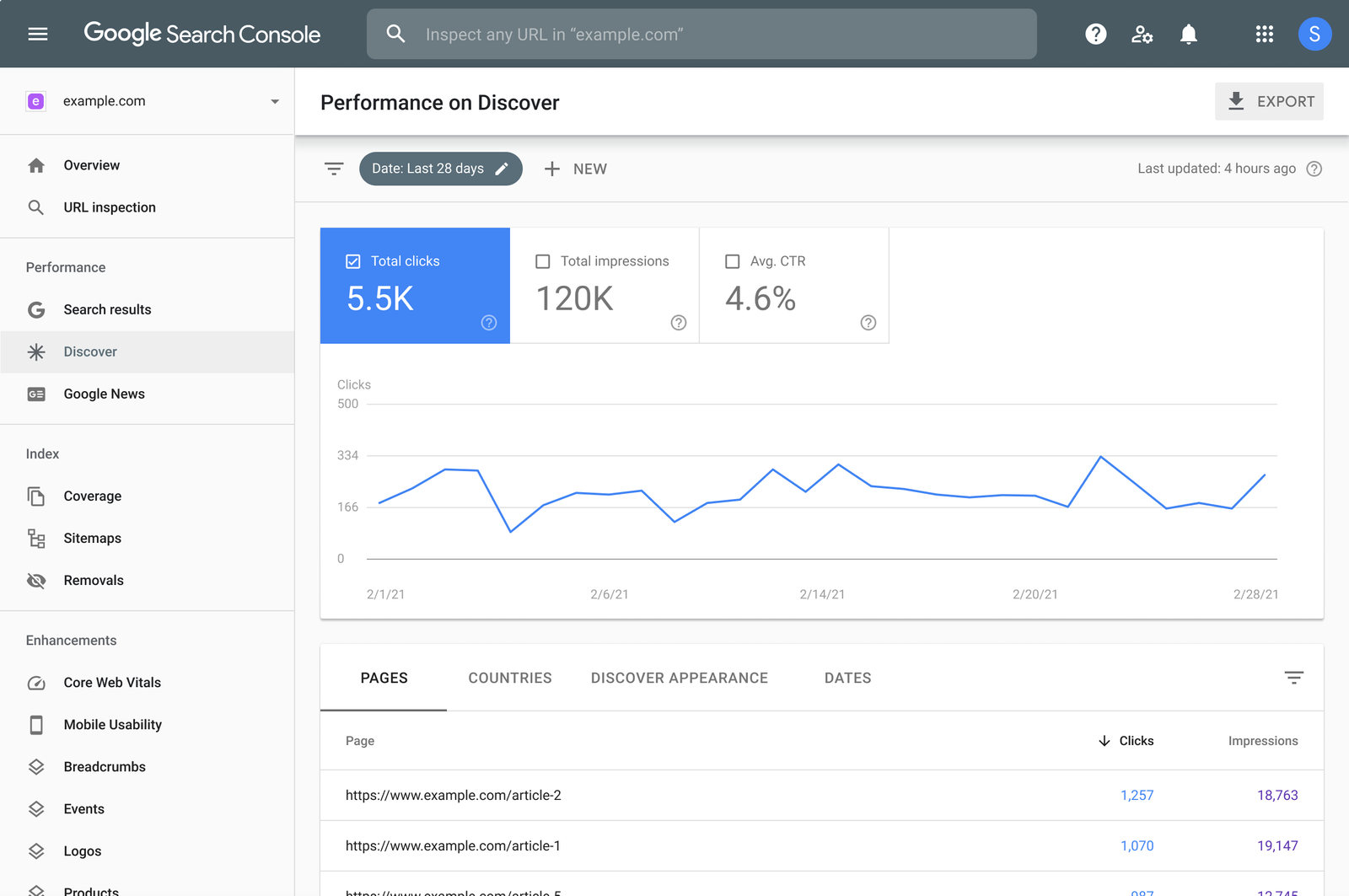
An image of Google Search Console Discover performance report. (Source)
In case you are unfamiliar with Google Search Console (GSC), it is a free tool provided by Google that helps website owners monitor, maintain, and troubleshoot their site’s presence in Google search results. GSC is an essential tool for SEO professionals and website owners to optimise their site’s performance in Google search. If you do not have Google Search Console yet, go to https://search.google.com/search-console/about to learn more about it and how to set it up.
Once you have set up GSC, don’t worry if nothing is showing. Depending on the complexity of your site, it can take a few days or weeks for data to appear.
By looking at keywords you’re already generating traffic for using Google Search Console (GSC), you might:
- Hidden Gems: Discover relevant keywords you might have missed during initial research, indicating user interest you can capitalise on.
- Refined Strategy: See which keywords bring in traffic and refine your content strategy to target these high-performing terms.
- Gaps & Opportunities: Identify areas where your website doesn’t rank for relevant keywords and create content to capture a wider audience.
- Content Optimisation: Knowing which keywords drive traffic helps you optimise existing content to match search intent better and potentially improve rankings.
- Performance Measurement: Track valuable data like clicks, impressions, and click-through rate (CTR) to gauge your keyword strategy’s effectiveness and identify areas for improvement.
- Track Progress: Monitor how your rankings and traffic change over time to evaluate your SEO efforts and identify areas needing adjustments.
Once Google Search Console displays data, go to Performance Results. There, you’ll find a graph showing website traffic from Google searches and a table underneath listing the search queries or terms used in searches where your site appeared.
Use your judgment; not all queries will be gold, but some will be valuable additions to your keyword list. GSC also allows you to filter data by various criteria like date range or CTR to get more specific insights into your keyword performance.
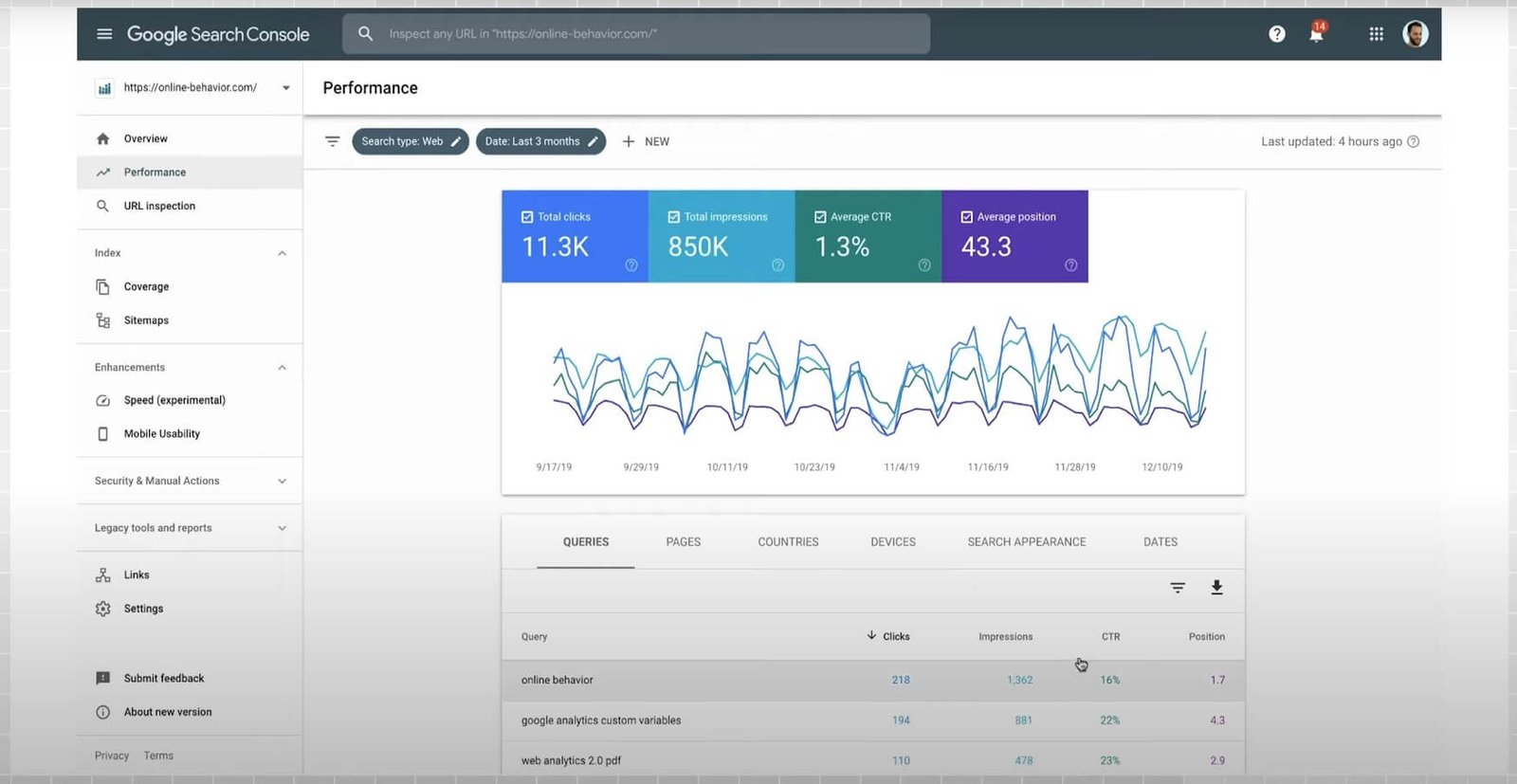
A screenshot of the GSC performance section. (Source)
Step Four - Check Your Keywords With Google
Before implementing your keywords, it’s important to validate your initial research and refine your keyword strategy. Head over to Google and type in your target keywords. What shows up in the search results? Analysing these results provides valuable insights:
- Content Types: Are the top-ranking pages blog posts, product pages, or something else? This tells you the type of content Google considers most relevant for that keyword. Aim to create a similar content type but make it more informative and helpful to the customer.
- Search Intent: Look at the page titles and descriptions of the top results. What kind of information are they offering? This can help you understand the user’s intent behind the keyword (informational, transactional, etc.).
This step is a secondary check to ensure there’s actual demand for the topic you believe users are searching for and to confirm your assumptions about their search intent. By validating your keywords, you’ll ensure you’re targeting the right audience with the right content.
Check out our previous article for a recap on user intent and keyword length.
Step Five– Google Trends
Google Trends is another free tool provided by Google that allows users to explore the popularity of search queries over time and across different regions. While not essential for the core keyword research process, it can be a powerful tool to enhance your strategy. It won’t tell you the exact search volume or competition level, but it can be incredibly useful for understanding seasonal fluctuations in search interest, identifying rising keywords, and brainstorming content ideas that capitalise on current trends.
Google Trends can be used for:
- Identifying Trending Topics
- Understanding Seasonal Trends
- Regional Interest
- Related Queries and Topics
- Content Ideation
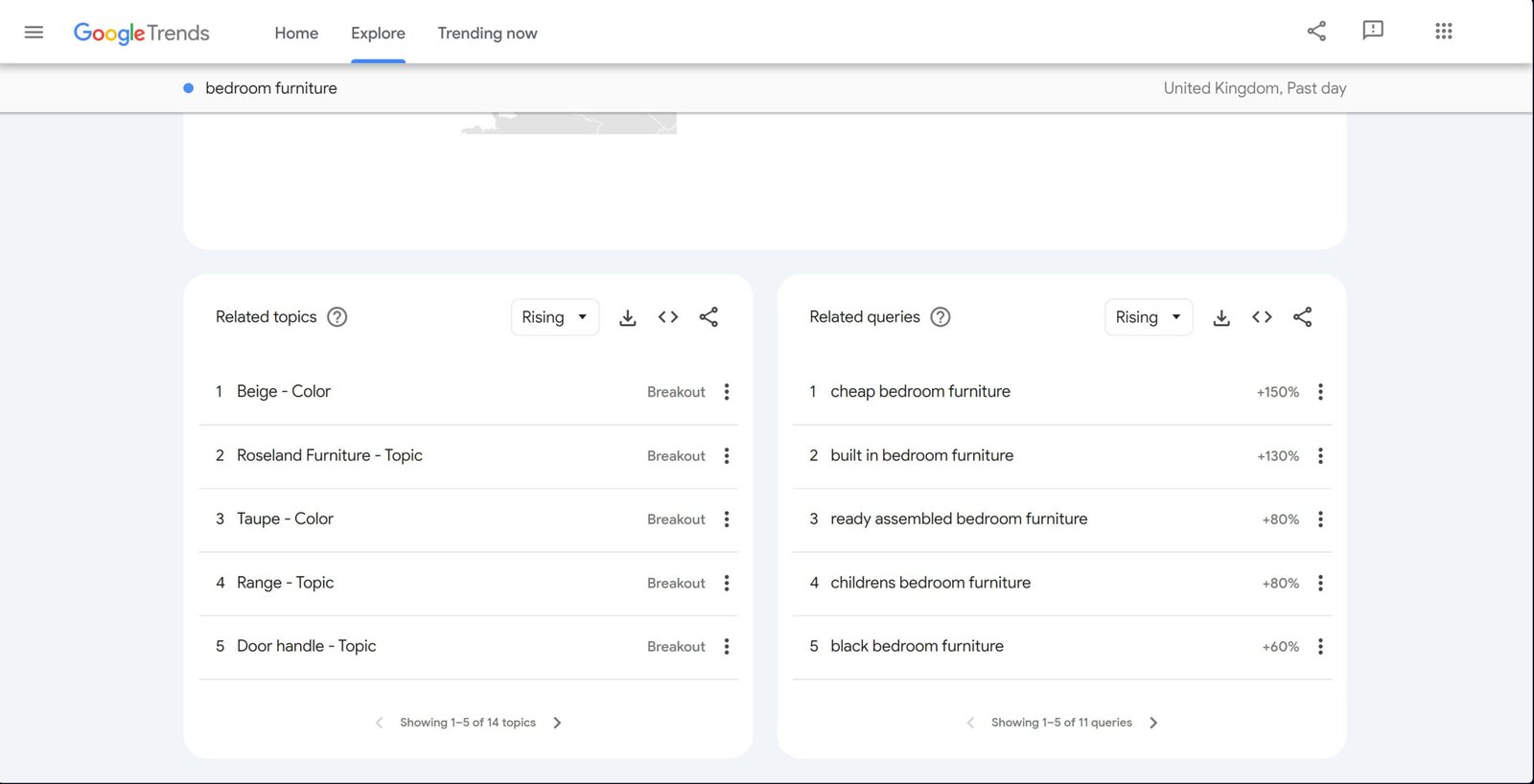
Image showing search results in Google Trends for bedroom furniture
In Google Trends, a breakout is represented by a sharp spike in the search interest graph, indicating that the interest in that keyword or topic surged significantly compared to its previous levels. This could be due to current events, viral trends, new product launches, or other factors that increase interest in that specific topic or keyword.
Identifying breakouts can be valuable for marketers, content creators, and businesses as it allows them to capitalise on emerging trends and adjust their strategies accordingly. By recognising breakout keywords early on, you can create relevant content, target specific audiences, and stay ahead of the competition.
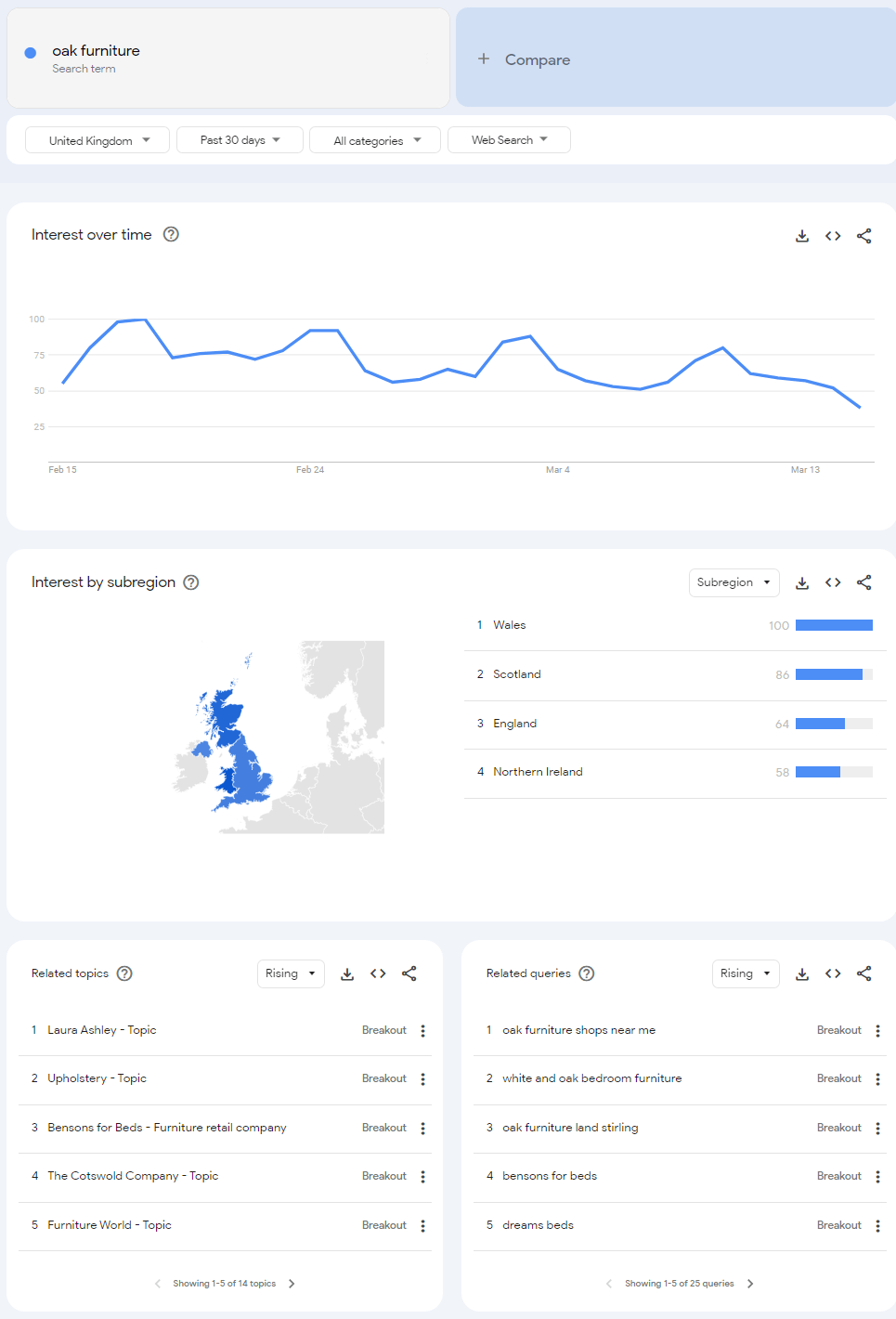
Image showing the results for oak furniture in Google Trends
Running every keyword on your list through Google Trends may not always be feasible, especially if you have many keywords to analyse. However, it could give the deciding vote on whether to target a keyword over another.
Overall, Google Trends offers insights into search trends, user behaviour, and keyword popularity, making it an additional tool for keyword research and content planning.
Seasonality Keywords
Seasonality keywords are search terms or phrases that experience fluctuations in search volume based on seasonal trends, events, or holidays.
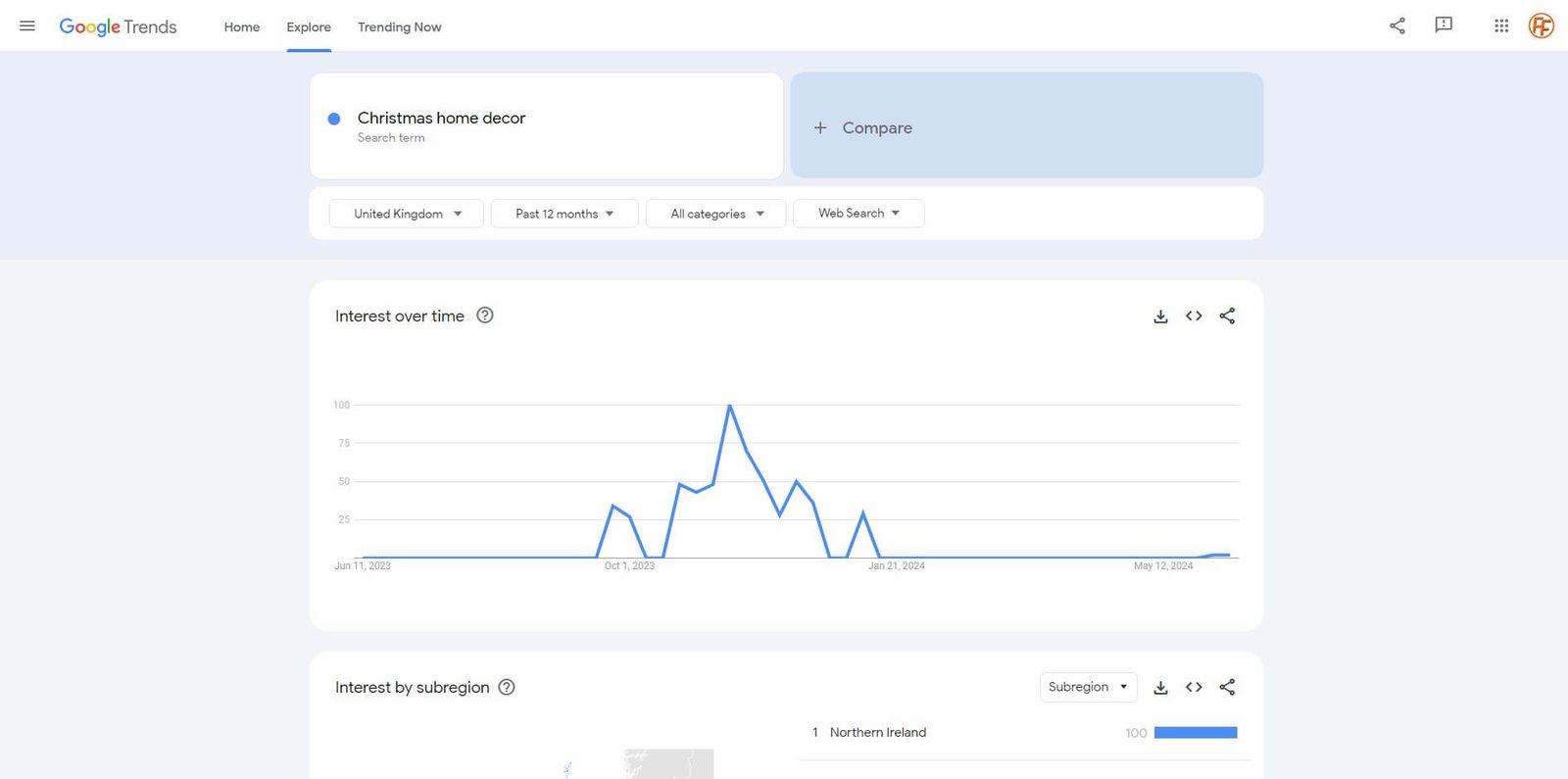
Image showing the Google Trends results for Christmas home décor
Seasonality keywords in the furniture industry may include “Thanksgiving dining sets” or “Christmas home decor,” reflecting consumers’ interest in sprucing up their homes for festive occasions. Additionally, keywords related to seasonal activities, like “outdoor patio furniture” in the summer or “cosy blankets” in the winter, can see fluctuations in search volume as consumers adapt their living spaces to the changing seasons.
By identifying and targeting seasonality keywords, you can tailor your marketing efforts to coincide with peak demand periods, adjust inventory, and enhance visibility in search results.
Prioritising Long Keyword Lists
Unless their offering is highly niched, almost all furniture businesses will have many products and services, resulting in potentially hundreds of keywords. By now, you should have an extensive list, including keywords you already rank for and ones you hope to target.
However, addressing them all at once is impractical. Focus is needed. For the implementation of any strategy to be given the best chance of success, no matter the area of your business, you need focus. Keyword research is no different.
Choose a manageable number of keywords to focus on at first. For example, doing blocks of 5-10 high-priority keywords at a time, ensuring they are successfully implemented before moving on to others.
Prioritising Your Keywords - Free Keyword Research Tools
Keyword research without tools isn’t entirely guesswork. You can develop an initial keyword list by understanding your target audience and brainstorming relevant terms. However, without data to validate your list, it can be challenging to gauge how effective the keywords will be for your business. This can lead to frustration and a feeling that SEO isn’t working for your business.
Fortunately, free, albeit limited, keyword research tools are available to help you refine your list. These tools can provide insights on:
- Search Volume: How often people are searching for a particular keyword.
- Competition Level: How difficult it is to rank for a keyword.
- Related Searches: Additional keywords people are searching for that might be relevant to your business.
Here are some popular free tools to get you started:
- Google Keyword Planner: While not as comprehensive as paid tools, it offers a good starting point for keyword research. It provides search volume estimates and competition levels for keywords. (https://ads.google.com/home/tools/keyword-planner/)
- Answer the Public: This tool helps generate keyword ideas based on people’s questions. It’s a great way to discover long-tail keywords with high intent. (https://answerthepublic.com/)
- KeywordTool.io for keyword suggestions, search volume estimates, and long-tail keyword variations. (https://keywordtool.io/)
- Ubersuggest: This tool offers limited free features, including keyword suggestions and search volume estimates. (https://app.neilpatel.com/)
- Keyword Sheeter: This free tool allows you to generate a large number of keyword ideas quickly, leveraging Google’s autocomplete feature. It’s a good option for brainstorming broad keyword lists. (https://keywordsheeter.com/)
While “free” keyword research tools offer a valuable starting point, they typically provide limited data and functionality. You might encounter restrictions on the number of daily searches you can perform or the depth of information available for each keyword. You’ll often need to create an account or upgrade to a paid plan to access features like advanced search volume metrics, competition analysis, and historical keyword trends.
Make sure that the keywords you are prioritising are the best ones for your business growth at this current time. Double-check your list against the following:
- Business Goals: Align your keyword choices with your primary goals. Are you aiming for brand awareness (e.g., prioritise keywords containing your brand name), increased sales of specific products (e.g., prioritise keywords related to those products), or driving traffic to physical stores (e.g., prioritise keywords with local search intent)?
- Search Volume & Competition: Target keywords with a healthy balance of search volume (how often people search for them) and lower competition (which makes them easier to rank for). Tools like Google Keyword Planner can help with this research.
- Relevance: Choose keywords highly relevant to your products, services, and target audience. Don’t chase high-volume keywords that aren’t a good fit for your business.
- Existing Website: Consider which pages you want to improve ranking for existing keywords and which keywords necessitate creating new content. For example, if a high-priority keyword doesn’t have a dedicated page on your website, creating a new page targeting that keyword could be a good strategy.
By following these steps and using the free tools mentioned, you can effectively prioritise your long keyword list and optimise your SEO strategy for better results.
Keyword Research Paid Tools
The keyword research process we have outlined has focused on free tools. However, paid keyword research tools become valuable as your business grows and your SEO strategy scales. Similar to outsourcing furniture deliveries to concentrate on your core business and customer satisfaction, paid tools can streamline keyword research, monitoring, and optimisation efforts.
Why Consider Paid Tools?
- Identifying Your Existing Rankings and Keyword Gaps:
- Free tools provide a good starting point, but paid tools offer a more comprehensive view of your website’s ranking for relevant keywords.
- Additionally, paid tools offer advanced features like keyword gap analysis. This helps you identify keywords your competitors rank for but don’t. These “gaps” present opportunities to expand your reach and attract new customers.
- Free tools provide a good starting point, but paid tools offer a more comprehensive view of your website’s ranking for relevant keywords.
- Competitor Analysis:
- Paid tools offer advanced competitor analysis, allowing you to see not just their top keywords but also their backlink profile and content gaps. This can help you identify opportunities to create high-performing content that attracts their audience.
- This can involve analysing and identifying their key pages, uncovering their backlink profile (links from other websites), and discovering content gaps where you can create informative content to attract their audience.
- Paid tools offer advanced competitor analysis, allowing you to see not just their top keywords but also their backlink profile and content gaps. This can help you identify opportunities to create high-performing content that attracts their audience.
Paid tools offer additional features beyond basic keyword research. Including:
- Pricing: flexible plans that can scale with your business needs as you grow.
- Automation: Save time with features that automate keyword research, rank tracking, and competitor monitoring.
- Comprehensive Data: Access a wider range of keyword data, search volume estimates, and competition levels for more informed decisions.
- Technical Support: Benefit from dedicated customer support and ongoing updates to ensure you get the most out of the tool.
Ultimately, the choice depends on your budget, specific needs, and SEO goals.
Important Note: Estimates, Not Guarantees
It’s important to remember that keyword research tools don’t have direct access to Google’s or any other search engine’s internal data. They rely on their own algorithms to estimate these metrics. As a result, the data you see may vary slightly between different tools.
Find the Money-Making Keywords.
You want to look at the leading indicators of the keyword value, including elements like volume, CPC, and the difficulty in ranking, which is usually displayed as Keyword Difficulty (KD) or Rank Difficulty (RD).
The highest traffic volume should not be used as a sole indicator of value. Short-tail keywords like oak furniture, bedroom furniture, or sofas can have very high volumes but also have high competition. If you are a well-established company and think you have the time and budget to pursue these keywords, then do so, but for most businesses, these would not be the best keywords to aim for.
Don’t forget medium to long-tail keywords. These can have lower traffic volume but a higher chance of conversion. It would be better initially to start targeting these keywords, as even though they have a smaller volume, you are more likely to get a sale.
Free and paid tools use their own algorithm to estimate the data you see. A keyword may show zero traffic volume, but if you feel it is relevant to target, do so. As we said at the beginning, keyword research has no magic formula. It still requires your judgment. This is why it is vital to know your business, the target audience and the market in which you operate.
Remember, informative, well-optimised content will not rank alone. Helpful quality content is important, but backlinks and overall website authority are crucial. A website with a strong backlink profile and an established reputation in the industry will have a major advantage when competing for keywords, even with slightly less optimised content.
Ongoing Keyword Research
While keyword research is a cornerstone of SEO, it’s not a one-time project you can check off your list. Think of it more like maintaining a house: regular upkeep is essential to keep it in top shape. Search algorithms evolve, user preferences shift, and your content strategy might adapt over time. To stay ahead of the competition, ongoing research is essential.
Schedule & Prioritise:
- Regular Reviews: Set aside some time each quarter or twice a year, but no longer than 12 months, to revisit your keyword strategy.
- Data-Driven Decisions: Don’t get bogged down by every keyword. Look at your content performance data. Are high-traffic keywords not converting as well as you’d hoped? Maybe they need a refresh or a new angle. Or are some keywords driving conversions but not much traffic? It might be time to promote them further.
Optimising Your Keyword Strategy:
- Industry Knowledge is Power: Follow industry publications and blogs (especially Furniture Fuel, Wink Wink) to stay updated on SEO best practices and trends, refining your keyword strategy based on the latest developments.
- Content Optimisation: Don’t let your existing content gather dust! Use your new keyword insights to optimise older pieces.
- Organised Knowledge is Power: Keep your keyword research organised! A central repository, like a spreadsheet or document, is your friend. Track keywords, search volume, competition level, and content performance. This way, you can quickly revisit your data and analyse how your strategy is evolving over time.
Remember, successful SEO is a marathon, not a sprint. By incorporating ongoing keyword research into your routine, you’ll ensure your content stays relevant, attracts your target audience, and continues to perform well in search results.
